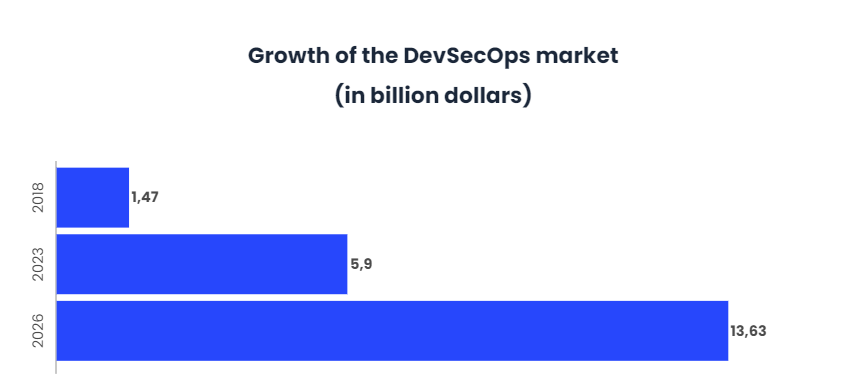DevSecOps: a new work philosophy

All organisations, whether large or small, are under constant pressure to increase innovation and accelerate delivery of new products. In order to achieve this, many choose to adopt DevOps to achieve increased flexibility and efficiency.
DevOps has greatly transformed the way organizations work and software development projects are executed. It combines the basic principles of development with a faster and shorter lifecycle approach. DevOps also ensures that functions and fixes are implemented frequently and quickly.
However, if maximum value is to be achieved in relation to the responsiveness and agility of DevOps, security must play an indispensable and integrated role throughout the software development cycle. And this is where DevSecOps comes in.
The importance of safety
The security testing of a software was traditionally done at the end of the development process, almost at the last minute, and with the intention of launching a product on the market as soon as possible and at the time that was considered most appropriate in order to have an advantage over the competition, leaving aside security.
This worked when software updates and releases were once or twice a year. But as companies adopted Agile and DevOps methodologies, and began migrating to the cloud, those development cycles were reduced to weeks or even days, giving way to an exponential increase in cyber attacks and security breaches that cost companies millions in damages. But in addition to the economic and reputational damage, today there are also the sanctions imposed by governments under laws such as the GDPR.
Given that both the possibility of a cyber attack and the potential damage are greater than ever, there is no better time than now for organisations to start developing additional security capabilities.
The logical extension of the DevOps cultural change to address this need is DevSecOps.
What is DevSecOps?
DevSecOps, an acronym for Development, Security and Operations, incorporates security as the main concern and throughout the entire life cycle of software delivery rather than treating it as a separate and potentially optional concern.
Due to the growing need for security in business and the increased use of the DevSecOps methodology, the market size is estimated to increase from $1.47 billion in 2018 to $5.9 billion in 2023, and this figure is expected to reach $13.63 billion by 2026.

The main objective of DevSecOps is to incorporate security awareness into the whole process of delivering value from software ideation to implementation, delivery and monitoring. It addresses security issues as they arise, when they are still easier, faster and less costly to solve.
In addition, DevSecOps makes application and infrastructure security a shared responsibility of the development, security and IT operations teams, rather than the sole responsibility of a security silo. This enables the delivery of more secure software by automating the delivery without slowing down the software development cycle.
As with DevOps and the Agile methodology, this method is interpreted and implemented in the most efficient way possible, minimising bureaucracy and maximising the delivery value to customers.
Why is it important to implement DevSecOps?
The push towards DevSecOps is necessary because of two key changes that have taken hold in recent years.
- New technologies: Technology has undergone many transformative changes in the last two decades. The transition to cloud computing, resource sharing and dynamic provisioning have generated unprecedented gains in speed, cost and agility. All this has greatly enhanced application development capabilities. In particular, the ability to deploy applications in the cloud has accelerated the scale and speed of software development. This, in turn, has precipitated a shift to DevOps and Agile methodologies.
- Development speed: As mentioned above, DevOps has drastically changed the speed and frequency of development cycles. What used to take months or years can now be done in weeks or days. Existing security and compliance monitoring tools were not created to keep up with the rapid pace of change required by DevOps. If security models are not modified to meet the new expectations, companies can have serious security problems.
- The need for security: Security is one of the greatest challenges that can have serious consequences if handled inefficiently, as it can cause the death of an enterprise. Security must be integrated into the entire process to allow the team to witness the potential of Agile methodologies without compromising the goal of creating a secure code.
Benefits of using DevSecOps
The benefits of DevSecOps are relatively simple. On the one hand, a better collaboration between the security and development teams at the beginning of the project cycle provides multiple advantages in the long term. And in general, increased security automation in the development cycle reduces the risk of errors and the danger of mismanagement, which could inadvertently lead to production attacks or downtime. But more specifically, DevSecOps offers the following advantages:
Fast and cost-effective software delivery
When software is developed in a non-DevSecOps environment, security issues can cause huge delays. Fixing the code and security problems can be very time consuming and expensive. The fast and secure delivery of software with DevSecOps saves time and reduces costs by minimizing the need to repeat a process to address security issues.
This is more efficient and cost effective, as having the security built in eliminates duplicate reviews and unnecessary rebuilding, resulting in more secure code.
Improved security
DevSecOps introduces cybersecurity processes from the beginning of the development cycle. Throughout the cycle the code is reviewed, audited, scanned and tested for security issues. These problems are addressed as soon as they are identified, which avoids reaching major problems that become more costly to solve.
In addition, collaboration between the development, security and operations teams improves the organisation’s response to incidents and problems when they occur. DevSecOps practices reduce the time to patch vulnerabilities and free up security teams to focus on higher value jobs.
Increased customer confidence
Customers may not know if a company is implementing DevSecOps at first, but it becomes evident over time. Constant security breaches cause a product to lose many, if not all, users, as no one trusts a product that has had a security breach.
A process that adapts
As organisations grow and mature, security also matures. DevSecOps lends itself to repeatable and adaptable processes, ensuring that security is consistently applied throughout the environment as the business changes and adapts to new requirements.
A mature implementation of DevSecOps will have very robust automation, also robust configuration management, orchestration, containers, immutable infrastructure and even serverless computing environments.
Possible obstacles
When a company wants to move to DevSecOps it may encounter obstacles due to deficiencies in the responsibilities of existing developers, governance structures and lack of skills and solutions.
In addition, the number of professionals specialized in DevSecOps is relatively low, and there is no one-size-fits-all solution due to differences in policies, infrastructure and business requirements.
There are also problems of collaboration between the Development, Security and Operations teams, due to the complexity of forming this type of team.
However, none of these challenges are insurmountable, and once overcome it is almost impossible for a threat to penetrate the software.
Conclusions
Software security was often treated as an afterthought, even considered an obstacle to gaining or maintaining an advantage over the competition. However, circumventing or postponing safety is a risky strategy that could have far-reaching repercussions once the application is in production.
DevSecOps creates a layer of security throughout the development, teams automate security to protect not only the development environment and data, but also the integration and continuous distribution processes (CI/CD).
So far, companies that have adopted this philosophy have experienced positive results thanks to the integration of security, shortening feedback processes, improving controls and reducing incidents through shared responsibility.
As technological innovation advances and the value of data grows, security becomes an indispensable part of development, and companies that want to keep pace with the competition will have to launch products faster and with security at the forefront of every phase of the software development life cycle.


